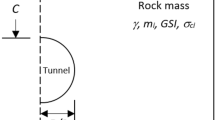Abstract
Based on strength reduction theory, the stability numbers of shallow tunnels were investigated within the framework of upper and lower bound theorems of limit analysis. Stability solutions taking into account of water seepage were presented and compared with those without considering seepage. The comparisons indicate that the maximum difference does not exceed 3.7%, which proves the present method credible. The results show that stability numbers of shallow tunnels considering seepage are much less than those without considering seepage, and that the difference of stability numbers between considering seepage and without considering seepage increase with increasing the depth ratio. The stability numbers decrease with increasing permeability coefficient and groundwater depth. Seepage has significant effects on the stability numbers of shallow tunnels.
Similar content being viewed by others
References
ZHAO Ming-hua, LIU Jian-hua, LIU Dai-quan, WANG You. Force analysis of pile foundation in rock slope based on upper-bound theorem of limit[J]. Journal of Central South University of Technology, 2008, 15(3): 404–410.
YANG Xiao-li, LI Liang, YIN Jian-hua. Stability analysis of rock slopes with a modified Hoek-Brown failure criterion[J]. International Journal for Numerical and Analytical Methods in Geomechanics, 2004, 28(2): 181–190.
YANG Xiao-li, LI Liang, YIN Jian-hua. Seismic and static stability analysis for rock slopes by a kinematical approach[J]. Geotechnique, 2004, 54(8): 543–549.
YANG Xiao-li, YIN Jian-hua. Slope stability analysis with nonlinear failure criterion[J]. Journal of Engineering Mechanics, 2004, 130(3): 267–273.
DAWSON E M, KOTH W H, DRESCHER A. Slope stability analysis by strength reduction[J]. Geotechnique, 1999, 49(6): 835–840.
CHENG Y M, LANSIVAARA T, WEI W B. Two-dimensional slope stability analysis by limit equilibrium and strength reduction methods[J]. Computers and Geotechnics, 2007, 34(1): 137–150.
KANG K W, KIM H S, KIM M S, KIM J K. Strength reduction behavior of honeycomb sandwich structure subjected to low-velocity impact[J]. Materials Science and Engineering, 2008, 483/484(1/2): 333–335.
LEE I M, NAM S W. The study of seepage forces acting on the tunnel lining and tunnel face in shallow tunnels[J]. Tunnelling and Underground Space Technology, 2001, 16(1): 31–40.
LIN H I, LEE C H. An approach to assessing the hydraulic conductivity disturbance in fractured rocks around the Syueshan tunnel, Taiwan[J]. Tunnelling and Underground Space Technology, 2009, 24(4): 222–230.
NAKAMURA H, KUBOTA T, FURUKAWA M, NAKAO T. Unified construction of running track tunnel and crossover tunnel for subway by rectangular shape double track cross-section shield machine[J]. Tunnelling and Underground Space Technology, 2003, 18(2/3): 253–262.
DAVIS E H, DUNN M J, MAIR R J, SENEVIRATNE H N. Stability of shallow tunnels and underground openings in cohesive material[J]. Geotechnique, 1980, 30(4): 397–416.
CHEN Jing-xi, KE Peng-zhen, ZHANG Guang. Slope stability analysis by strength reduction elasto-plastic FEM[J]. Key Engineering Materials, 2007, 345/346(1): 625–628.
LI R Q, YU Y Z, DENG L J, LI G X. Stability analysis of unsaturated soil slope by 3D strength reduction finite element method[J]. Geotechnical Special Publication, 2006, 148: 62–69.
DAWSON E M, NESARAJAH S, ROTH W H. 3D Geotechnical stability analysis by strength reduction[J]. ASCE Special Publication, 2000, 101: 99–113.
Author information
Authors and Affiliations
Corresponding author
Additional information
Foundation item: Project(200550) supported by the Foundation for the Author of National Excellent Doctoral Dissertation of China; Project(09JJ1008) supported by Hunan Provincial Natural Science Foundation of China; Project(200631878557) supported by West Traffic of Science and Technology of China
Rights and permissions
About this article
Cite this article
Yang, Xl., Huang, F. Stability analysis of shallow tunnels subjected to seepage with strength reduction theory. J. Cent. South Univ. Technol. 16, 1001–1005 (2009). https://doi.org/10.1007/s11771-009-0166-4
Received:
Accepted:
Published:
Issue Date:
DOI: https://doi.org/10.1007/s11771-009-0166-4




